An Introduction to the Wonderful World of Reptiles and Amphibians
Although reptiles and amphibians are distant relatives on the tree of life, they are often found together due to the similar habitats they occupy. Collectively, reptiles (i.e., lizards, turtles, snakes, and crocodylians) and amphibians (i.e., frogs, salamanders, and the eel-like caecilians) are called herpetofauna, herptiles, or herps. The “herp” prefix is derived from the Greek term herpetón, meaning “creeping animal.” These animals are often misunderstood and feared, likely due to their secretive nature and the perceived danger of venomous snakes and poisonous frogs. However, only 20 of the 120 snake species in the United States are dangerous to humans, and the venomous snakes are extremely unlikely to bite. They bite defensively only as a last resort, for instance, if they are handled or cornered (Russell 1980). Likewise, amphibians are generally not dangerous to humans.
Herps play several vital roles in our ecosystem, serving as both predators and prey. The predator herps, among them crocodylians, snakes, lizards, and frogs, eat animals such as insects and rodents, several of which act as reservoirs for zoonotic diseases. Frogs, lizards, snakes, and many more herp species also serve as important sources of food for predators like foxes, badgers, bobcats, and birds of prey, to name a few. Additionally, some reptiles serve as ecological engineers. Gopher tortoises, for instance, dig capacious burrows that provide homes for hundreds of native species (Catano and Stout 2015).
To avoid predation, herps often hide underground, under leaf litter, in the mud, or underwater and have evolved patterns and coloration to camouflage themselves in their local habitat. Therefore, herps are more abundant than meets the eye and have an astonishing diversity, which is often overlooked due to their cryptic nature.
Learning how to observe and document herps will open a new-found appreciation for this group of diverse animals and contribute to our understanding of their biodiversity and spatial distribution (Figure 1). This knowledge is critical to the development of effective management and conservation practices for this often-overlooked group. Because herps can be cryptic, they require intentional searching and reporting to improve our understanding of their diversity. Observations provide insight on biology and evolution, unraveling fascinating adaptations, behaviors, and ecological relationships. You can make meaningful contributions to science by documenting reptiles and amphibians and sharing your observations on platforms like iNaturalist. Each observation becomes a valuable data point, collectively contributing to a better understanding of herps and the ecosystems they inhabit. By observing, photographing, and recording information about these species, anyone can participate in this scientific endeavor. The purpose of this document is to provide guidance and tips on how to enter the wonderful world of reptiles and amphibians, or ‘herping’, and further, how to leverage iNaturalist to document herp observations and contribute to science. The intended audience is anyone who is interested in the natural world and wants to learn more about observing herps, identifying herps, and contributing to science by adding their observations to iNaturalist.
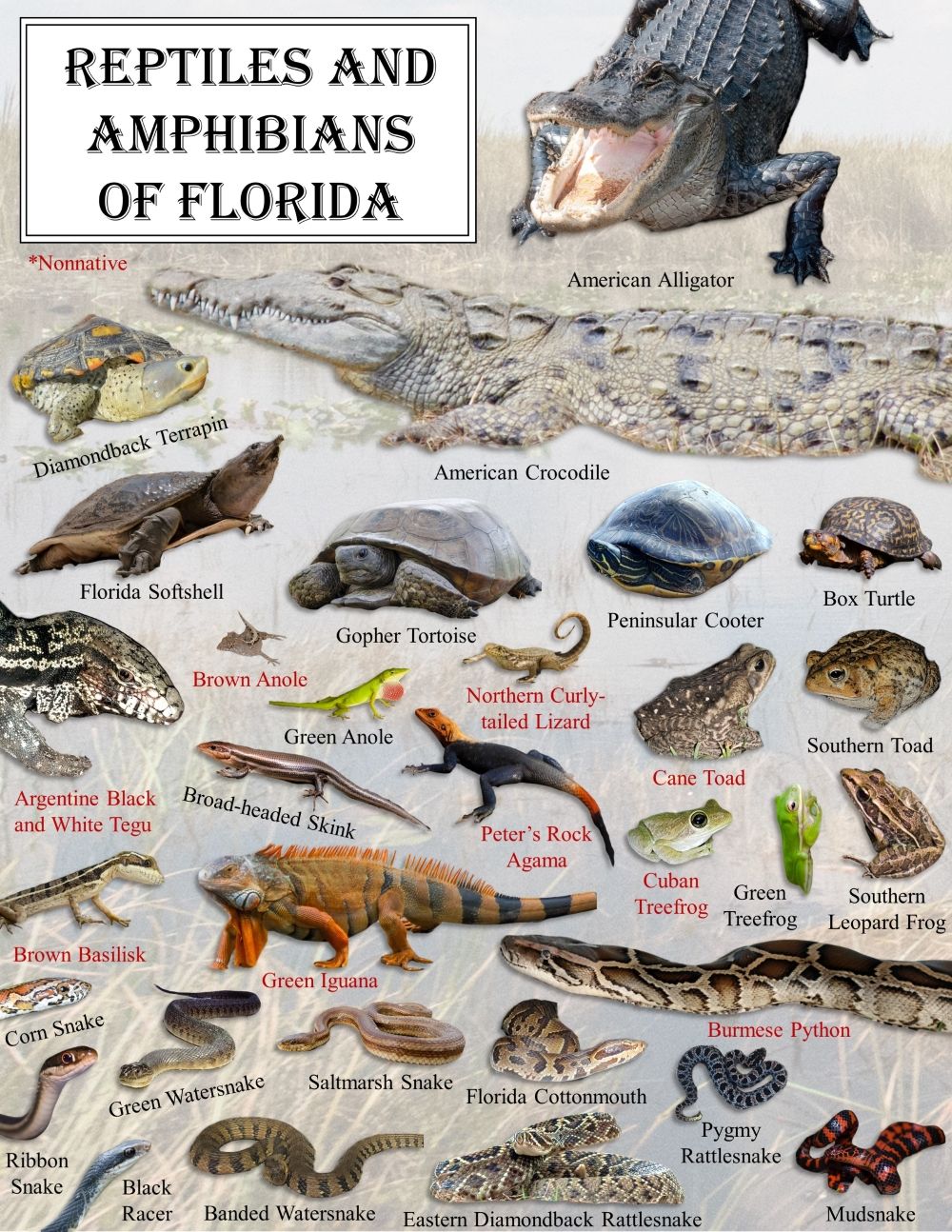
Credit: Brittany Mason and Corey Callaghan (python photo), UF/IFAS
Using iNaturalist to Document and Identify Reptiles and Amphibians
iNaturalist (https://www.inaturalist.org/) is a citizen science platform that combines the wonders of nature with the collective efforts of a global community. iNaturalist is an independent platform, allowing participants to contribute observations of any organism, or traces thereof, along with information about where and when that observation took place. The program is free to use and can be accessed via a user-friendly website and mobile app. The key to iNaturalist’s success lies in the precision and thoroughness of the contributed observations. Contributions that supply accurate information about species and locations become invaluable data points that help researchers, conservationists, and policymakers understand and safeguard the natural world. iNaturalist offers an excellent tool to anyone wishing to jump into the world of herps and herping. For more information on iNaturalist, see the iNaturalist “About” page, and see the “Getting Started” page for further details on how to get started. Some curated resources are available here.
Of the approximately 12,000 documented species of reptile in the world as of 2023, 8,225 have been submitted to iNaturalist, and from the approximately 8,500 documented amphibians in the world, 5,332 have been submitted to iNaturalist (“The Reptile Database” 2022; “AmphibiaWeb” 2023). In the United States, 598 reptile and 394 amphibian species have been submitted to iNaturalist with the most commonly reported reptiles and amphibians being western fence lizard, pond slider, American toad, green anole, common garter snake, brown anole, common box turtle, American bullfrog, green frog, and painted turtle (Figure 2). In Florida, 223 reptile and 79 amphibian species have been submitted to iNaturalist with the most commonly reported reptiles and amphibians being brown anole, American alligator, green anole, Cuban tree frog, gopher tortoise, green iguana, southern toad, North American racer, northern curly-tailed lizard, and Florida softshell turtle (Figure 2).
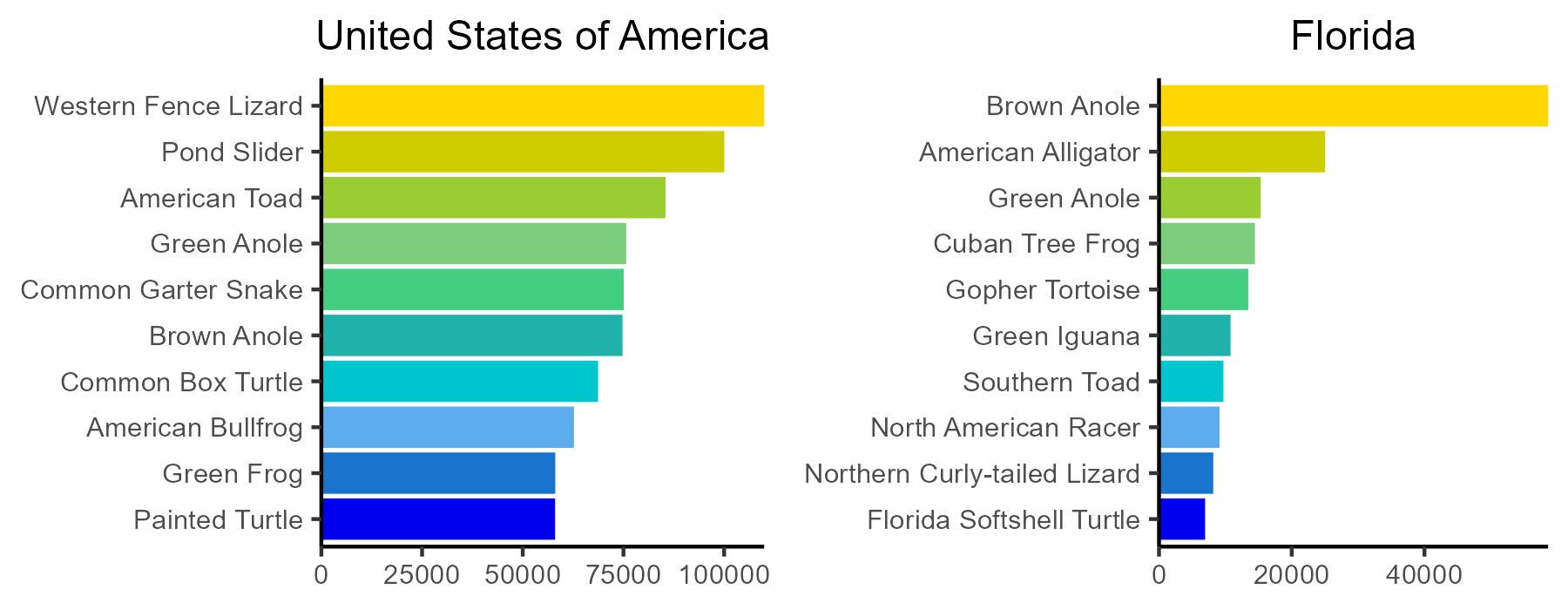
Credit:
Observing Reptiles and Amphibians
Reptiles and amphibians can be active at any time of the day depending on the species and weather. Herps are fully or mostly ectothermic (cold-blooded), meaning their body temperature fluctuates based on external temperatures, and they require warm temperatures for movement. In seasonal climates, herping should be done in the spring, summer, and fall. To maximize the diversity of reptiles and amphibians you observe, it is best to vary herping times because different species have different daily activity patterns and heat requirements. For example, salamanders are most likely to be observed moving when temperature are above freezing but below 70°F, whereas aquatic turtles and frogs may be observed in the water on even the hottest days. Additionally, utilizing a variety of search techniques will increase the diversity of reptiles and amphibians observed. For example, road cruising at night is best for finding a diversity of snakes, searching the water is best for finding turtles and frogs, night walking is best for finding frogs and arboreal species, flipping logs and rocks is best for finding salamanders, and listening for frog calls is an easy way to locate frogs (Figure 3). We explore each one of these herping strategies in more detail below.
For all searching techniques, safety is the top priority. Always wear a good pair of boots and long pants, especially when walking through brush in case you encounter poisonous plants, venomous snakes, or venomous insects. When hiking, stay on established trails where you are best able to see your immediate surroundings. Always look down when walking, not only to assess the terrain but also to look for venomous snakes and insects. Stop walking if you need to look away from the ground to scan further down the trail. If you spot something in the distance, make sure to continue to keep your eyes on the ground while walking towards the animal. It is easy to get excited about seeing wildlife, but do not forget about safety. If you see one snake, there is a chance there are others hiding in the brush nearby. When in a group, which is generally recommended when herping, communicate any potential dangers you observe. Lastly, always bring a first aid kit when hiking or spending time outdoors (see this publication from Johns Hopkins for venomous snake bite information).
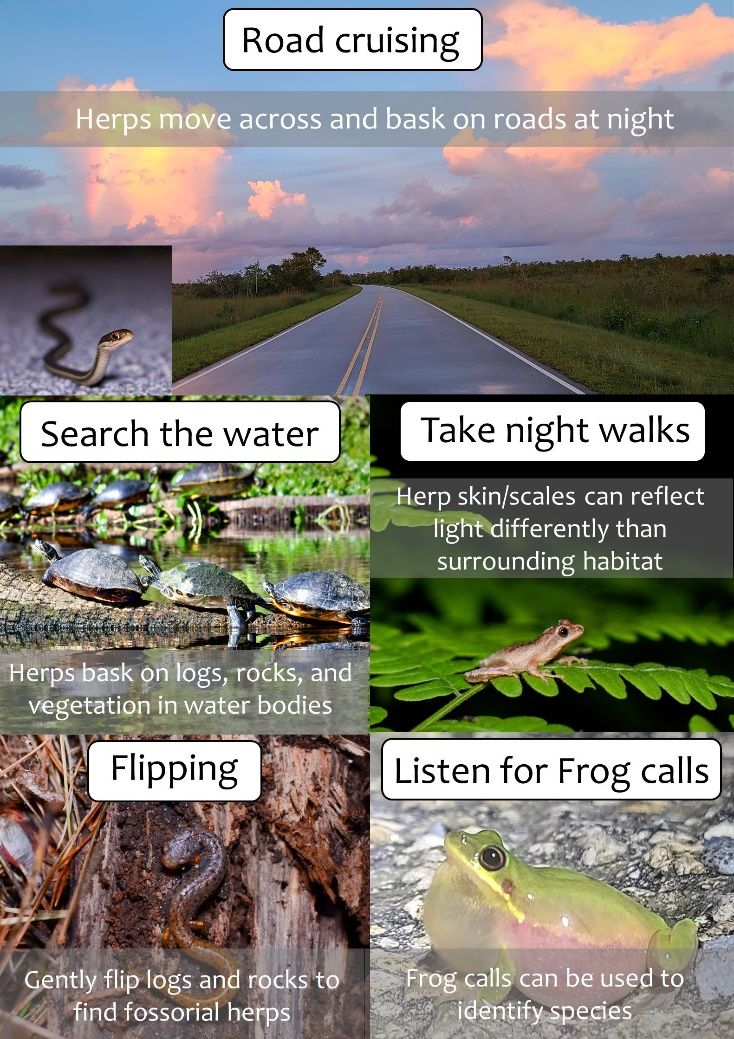
Credit: Brittany Mason, UF/IFAS
Road Cruising
Arguably the most popular method for finding reptiles and amphibians is road cruising, which involves driving a car slowly along roads during warm months, about an hour or two before sunset to a few hours after sunset. Road cruising is especially effective for finding amphibians during or immediately after rain. This technique requires either a headlamp (recommended to keep hands free) or a flashlight to use when getting out of the vehicle to observe herps. Road cruising is effective for finding herps because as the air temperature cools off at night, reptiles and amphibians use roads as a heat source to maintain their body temperature. Road cruising is most effective and safe when done with at least two people in the vehicle, so the driver can focus on driving while the passenger(s) search for herps. Choose roads next to natural habitat that have low traffic where night driving is permitted. (Some state parks prohibit driving at night on certain roads to protect wildlife from vehicles.) Roads near wetlands, rivers, and lakes can be especially good for finding herps. Where it is safe to do so, drive slowly enough to spot animals on the road. The best speed will vary according to the skill of the observing passengers and according to the terrain. (Your speed will necessarily be slower on gravel and dirt roads than on paved roads.)
Spotting a herp can be extremely exciting, but the driver and all passengers must remain calm to proceed safely. The driver must resist the urge to stop suddenly or haphazardly. Instead, take the time to assess the situation, make sure other vehicles are at a safe distance, and find a safe place to pull off the road. Once parked, turn on hazard lights to alert other drivers to your stopped vehicle. Do NOT jump out of the car right away. Take a moment to scan for traffic first to make sure you’re safe.
Use a flashlight or headlamp to locate the animal and take photos. Stay far enough away from the animal to avoid altering its behavior. Give extra space to venomous snakes, ensuring you are well out of striking range. Keep a close eye on movements by the snake and adjust your distance as necessary. If you are not sure whether a snake is venomous, err on the side of caution and treat it as a venomous snake. You may encounter roadkill, which is equally as valuable for citizen science research projects (Unger 2022). In this case, take photos of the carcass from many different angles, including close ups of the face and scale or scute patterns. Decaying animals can be difficult to identify, so usually the more pictures, the better. To get the best pictures of these animals, it may be necessary to move the carcass. Make sure to have disposable gloves handy for this purpose. It is best practice to take turns photographing animals, always ensuring that at least one person is keeping an eye out for oncoming traffic.
If you plan to participate in road cruising, it is important that you are aware of local laws and follow road regulations. Generally, road cruising is legal, but some states require a hunting permit, and some areas may forbid it altogether. Remember, parks (like some national parks) have their own set of rules, so even if road cruising is legal in your area, it may not be allowed in all parks. If you want to go road cruising in a park, reach out to park staff first to discuss your intentions and ask about the rules. Additionally, respect private property. Never drive on private roadways or enter private property without permission. Where road cruising is permitted, be respectful of wildlife by making photo sessions short and giving animals enough space. Always drive as slowly as possible given the road and traffic conditions to protect wildlife and avoid contributing to roadkill numbers.
Search the Water
Because water can be used by reptiles and amphibians to regulate body temperature, water is a great place to search for herps during the day. Most semiaquatic herps are found near freshwater or brackish water on exposed rocks, logs, or dense vegetation where they are most likely to bask. (Basking means lying in the sun or on a warm surface to raise body temperature.) You may see turtles or snakes swimming in open water. Amphibians are typically found along shallower parts of water or along the shoreline. Hiking next to water bodies or kayaking and canoeing along the water’s edge is the best way to search the water for herps. Binoculars and/or zoom cameras are recommended to observe animals (e.g., turtles) from a distance. Where permitted, a hand net for capturing frogs can make it easier to get photos. However, avoid handling frogs because oils and bug spray from your hands can make them sick or even kill them. Where it is safe and permitted, try snorkeling in clear water to find turtles swimming underwater.
Take Night Walks
Some species of reptiles and amphibians are more active at night, especially when daytime temperatures are high. Walking on a trail at night with a headlamp can be an effective way to find herps that are difficult to observe during the day. Many reptiles and amphibians have a glossy sheen on their scales/skin that is more reflective than the surrounding habitat, making these species stand out more at night when a headlamp or flashlight hits them. Trails in natural habitat, especially those next to freshwater, are ideal for finding herps. Make sure to occasionally stop and look in the trees for herps such as tree frogs and snakes, and check the ground for terrestrial herps like frogs, snakes, and salamanders. (Lungless salamanders, for instance, come out of hiding at night to forage and find mates.)
Flipping Rocks and Logs
Flipping rocks, logs, and debris in moist habitats can reveal salamanders, newts, and snakes hiding underneath. Use a field hook or garden hoe to lift objects and wear sturdy gloves to protect your hands against poisonous plants and insect bites and stings. Find rocks and logs that are intact and light enough to pick up. Do not pick up an object unless you are confident you can return it to the position you found it in, in the condition you found it in. Avoid severely rotted logs, and if an object that appeared solid begins to crumble when you try to pick it up, stop. Do not break up objects that serve as important habitat for a variety of animals.
Keep in mind that venomous snakes and insects often hide under rocks and logs, and take extra caution to avoid an accidental bite or sting. Before approaching objects, walk around them to ensure there are no animals present. Venomous snakes will occasionally rest near rocks and logs. Use your hook or garden hoe, not your hands. Position the hook or hoe on the opposite side of the object from where you are standing, and slowly tilt the object up and towards you. This way, the object will act as a shield to protect you from any venomous snakes hiding underneath it. Take a minute to search for animals in the dirt. If you spot an animal, gently lower the object away from the animal and photograph the species. Do not touch or move the animal to avoid causing it stress. Again, the “no touching” rule is especially important for amphibians. Their skin can absorb oils and bug repellent on your hands, which can make them sick or even kill them. Before leaving, carefully replace rocks and logs where you found them, making sure not to crush any animals in the process. Always follow local regulations and stay on marked trails.
Listen for Frog Calls
Frogs call, typically at night, to locate mates during the breeding season. Some species can be heard in fields or forests, while others are most often heard around bodies of water. Identifying frog calls is an easy way to survey species as the calls can be heard from great distances. To the untrained ear, it may be difficult to distinguish frog calls from insect calls. However, there are a multitude of resources online to listen to local frog calls, so you can become somewhat familiar (for Florida, see the Florida Museum’s frog call page). When you are comfortably familiar with local frog calls, take night walks along wooded areas, lakes, and ponds, and listen for frogs to record and upload to iNaturalist.
Know Before You Go
Because of the large wildlife trade for herps, there are laws and regulations in place to protect these species. Before you go herping, research and understand these regulations. Do not share precise locations of at-risk reptile and amphibian species. This includes species that are vulnerable, rare, or desirable in the pet trade. Study the local at-risk species before you go herping so you can help keep them safe (see here for some of the reptiles and amphibians in the United States that are at-risk). When posting your observations to iNaturalist, if poaching or collecting is a concern, you can use the obscured or private location feature (see here for more details). But if you do this, be sure to ensure that there are no landmarks or landscape features in the photo that could give away the animal’s location. It is important to always err on the side protecting the animal.
Always prioritize the well-being of wildlife and their habitats when documenting nature. Respect the natural behaviors of animals and maintain a safe distance during observations to avoid disturbing them. Be mindful of the sensitivity of habitats and ecosystems. Comply with local regulations to ensure the preservation of biodiversity and sustainable enjoyment of nature.
Best Practices for Taking Photos and Sound Recordings to Identify Reptiles and Amphibians
It is worthwhile to invest in a camera with zoom capabilities that will enable you to take the best possible photos of reptiles and amphibians while not disturbing their natural behavior. Many smart phones now feature zoom capabilities that can be used to take detailed photos of herps. Because many herping techniques require nighttime searching, a headlamp or flashlight is also necessary to find and take clear photos of herps at night. Headlamps are excellent for lighting your way while you’re walking, and they keep your hands free for photographs. A light can be useful during the day if you run across herps in dark places such as under logs. In general, taking photos of animals from multiple angles will increase the likelihood of capturing important features for identification. A clear photo of the animal’s face, one that shows the eyes, mouth shape, head shape, and distinctive patterning, is most useful for accurate identification. Additionally, take photos of the body patterning, coloration, and shape (Figure 4). Generally, these photos are best taken at an angle to capture the animal’s side profile and a portion of their back. Crop photos to eliminate excess background around subjects. Images should look similar to the photos in Figure 4.
You can use the iNaturalist app or your phone’s sound recording application to record frog calls on your phone. Ideally, frog calls should be recorded where there is minimal background noise. If possible, move away from loud roads, wait for cars or planes to pass by, and try to get away from people who are talking. If multiple frog species are calling, which is often the case, try to find a location where one frog species is calling the loudest and record in this location. When you post this sound recording to iNaturalist, it is good practice to describe the call you would like identified in the notes section of the observation by either its location in the recording via time stamp or a brief description of the call.
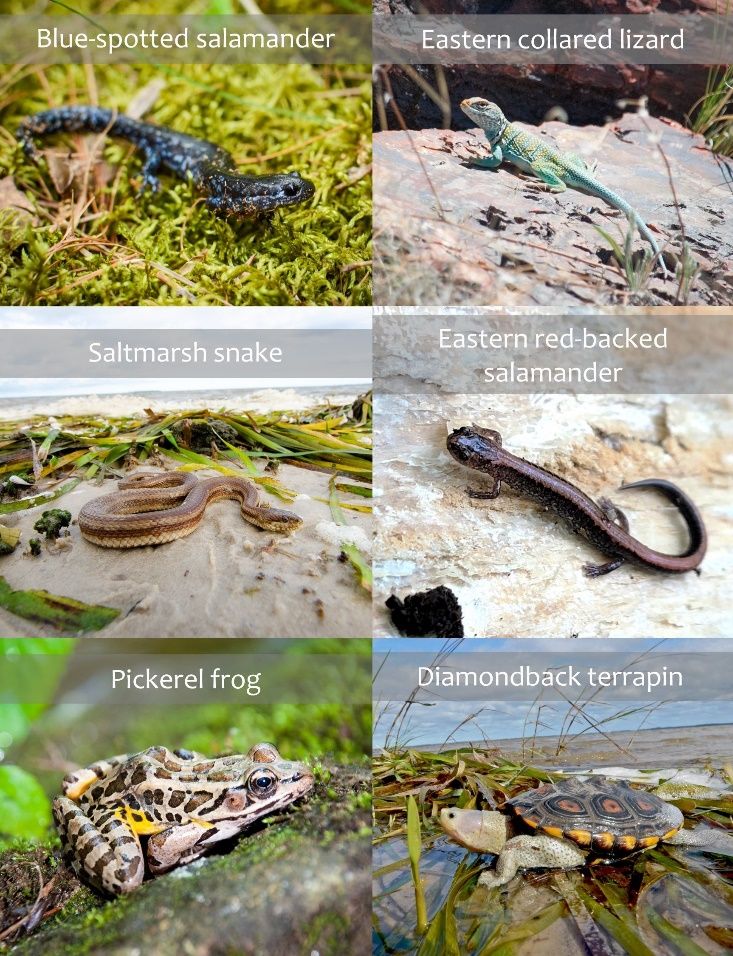
Credit: Brittany Mason, UF/IFAS
A Deeper Dive on Using iNaturalist to Understand the World of Herps Near You
The iNaturalist website is an excellent resource to explore reptile and amphibian observations worldwide. The best way to explore these species on iNaturalist is through the Explore page. This page features an interactive map that can be filtered by location and species (Figure 5). To explore reptile species, type “Reptiles” in the species search bar; similarly, for amphibians type “Amphibians” in the species search bar.
Filter the interactive map to your city using the location box and go to the “Species” tab under “Observations” from the Explore page to see a list of reptile or amphibian species from your city or local region (Figure 6). Learn more about each species by clicking on their entry. This will direct you to the species’ information page which contains a graph displaying what time of year a species is most likely to be observed and general information on the species from Wikipedia. The “Map” tab on this page displays an interactive map showing where this species has been observed.
Once you are familiar with reptile and amphibian identification, consider helping others identify their observations from the Identify page. This page provides a grid view of observations and can be filtered the same as described above from the Explore page (see “Identifying Observations” on this page for more information). This is a great way to engage in the iNaturalist community and learn more about the herp species in your area. Additionally, identifications increase the value of observations for scientific use (see Callaghan et al. 2022 to learn more).
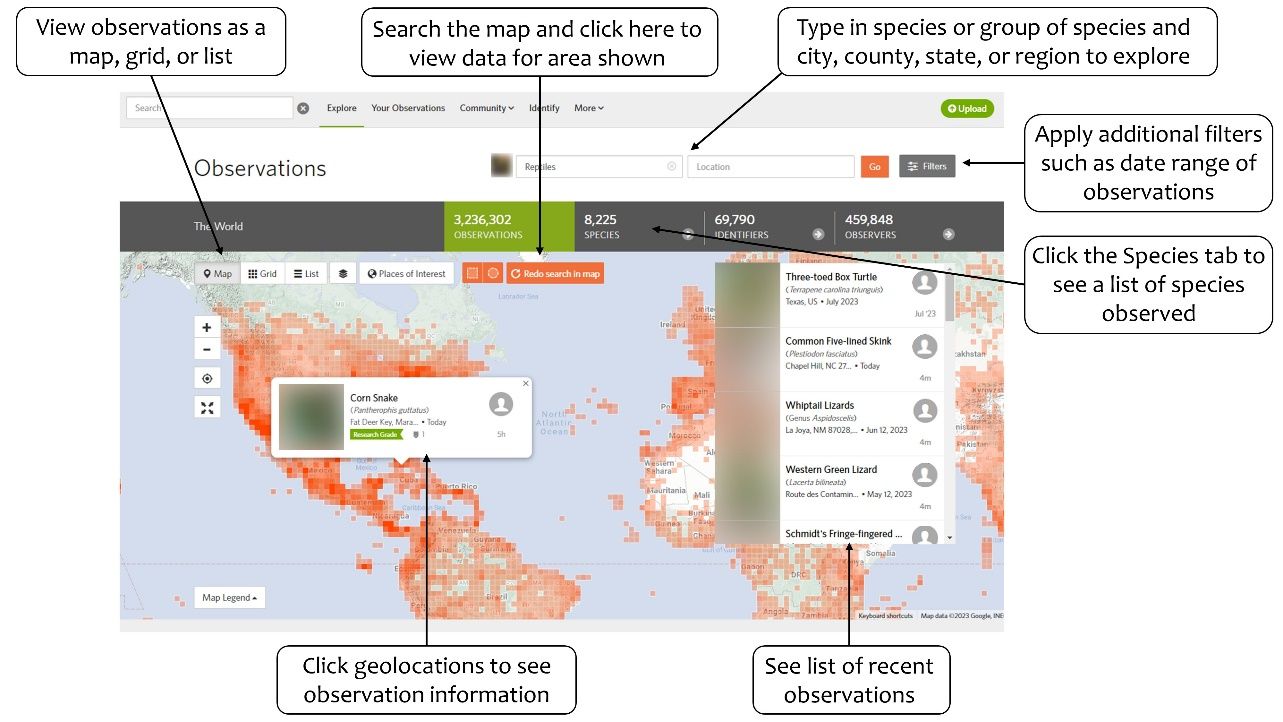
Credit: website screenshots from www.iNaturalist.org
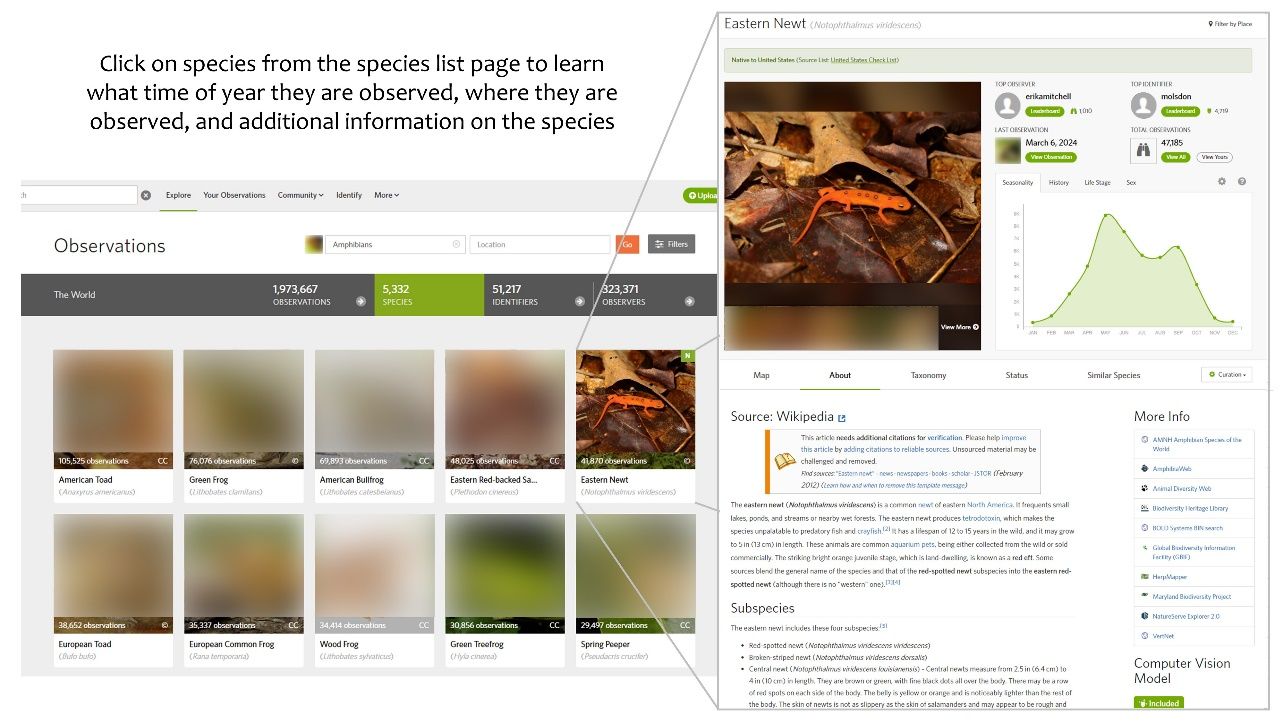
Credit: Website screenshots from www.iNaturalist.org and eastern newt photo by iNaturalist user shortia (CC BY-NC)
Conclusion
We described techniques in this publication helpful for spotting reptiles and amphibians and for making accurate observations and identifications of them. A working knowledge of reptile and amphibian characteristics, safety and wildlife protection considerations to bear in mind when searching for reptiles and amphibians, and guidelines for accurate and reliable identification and documentation are all essential to a successful herping adventure. Let’s continue documenting and exploring biodiversity responsibly through iNaturalist to contribute to our understanding of the natural world.
Additional Resources
“Field Herpetology Etiquette,” a pdf prepared by Partners in Amphibian and Reptile Conservation
List of threatened reptiles and amphibians in the United States Wikipedia page
The Field Herping Guide: Finding Amphibians and Reptiles in the Wild, a book by Mike Pingleton and Joshua Holbrook
“HELP! I found a…” Reptile and amphibian identification page by Steve Johnson's lab, UF/IFAS Department of Wildlife Ecology and Conservation
A Field Guide to Reptiles and Amphibians of Eastern and Central North America by Robert Powell, Roger Conant, and Joseph T. Collins
Peterson Field Guide to Western Reptiles and Amphibians by Samuel M. McGinnis and Robert Cyril Stebbins
References
“AmphibiaWeb.” 2023. AmphibiaWeb. https://amphibiaweb.org/index.html
Callaghan, Corey T., Thomas Mesaglio, John S. Ascher, Thomas M. Brooks, Analyn A. Cabras, Mark Chandler, William K. Cornwell, et al. 2022. “The Benefits of Contributing to the Citizen Science Platform iNaturalist as an Identifier.” PLoS Biology 20 (11): e3001843. https://doi.org/10.1371/journal.pbio.3001843
Catano, Christopher P., and I. Jack Stout 2015. “Functional relationships reveal keystone effects of the gopher tortoise on vertebrate diversity in a longleaf pine savanna.” Biodiversity and conservation 24 (2015): 1957-1974. https://doi.org/10.1007/s10531-015-0920-x
Russell, F. E. 1980. “Snake Venom Poisoning in the United States.” Annual Review of Medicine 31 (1): 247–59. https://doi.org/10.1146/annurev.me.31.020180.001335
“The Reptile Database.” 2022. The Reptile Database. https://reptile-database.reptarium.cz/
Unger, Shem. 2022. “On the Road Again: Touring iNaturalist for Roadkill Observations as a New Tool for Ecologists.” Journal of Wildlife and Biodiversity 6 (3): 72–86.